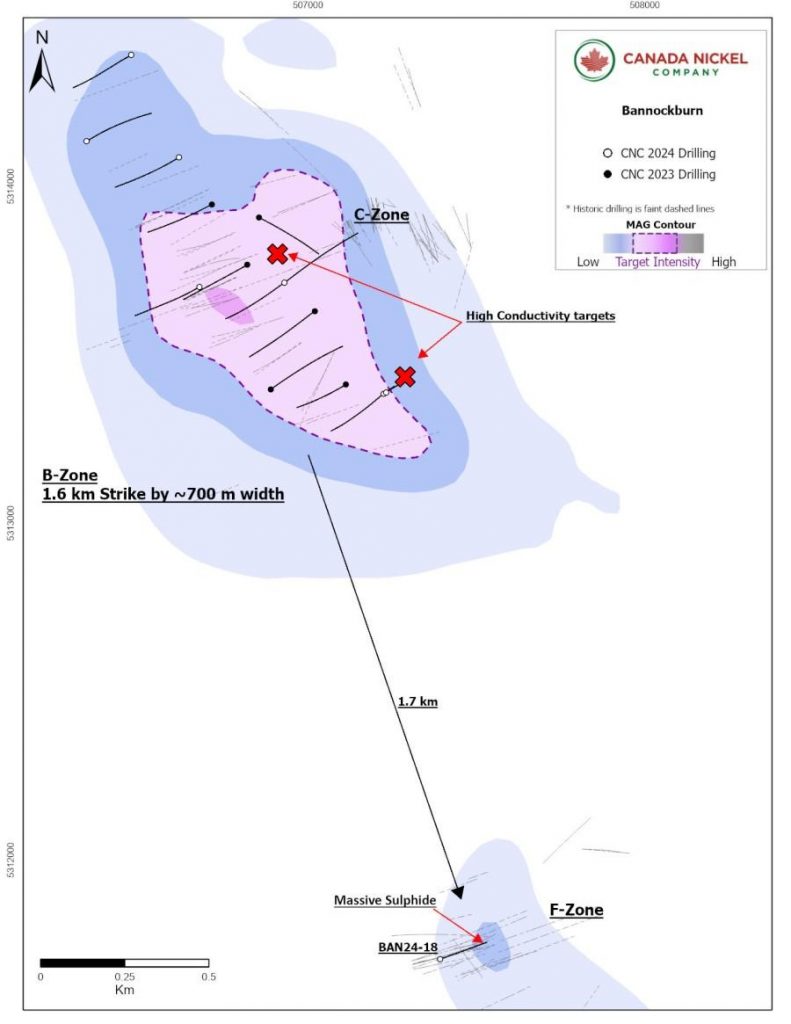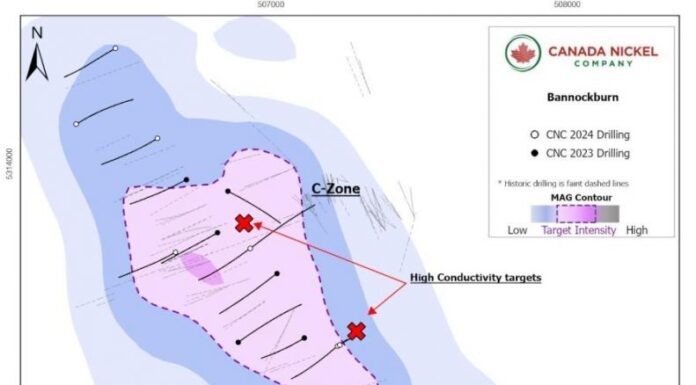
Canada Nickel Company (TSXV:CNC) has announced that it has intersected a major interval of massive sulphide mineralization at its Bannockburn Property, approximately 65 kilometers south of Timmins, Ontario. This milestone could mark a key advancement in the company’s exploration activities and add to its resource base, which aims to address the demand for nickel in electric vehicle batteries and stainless steel production.
CEO Mark Selby commented in a press release: “We have assembled a very large land package in the Timmins Nickel District which has yielded millions of tonnes of contained nickel resources. While our focus has been primarily on large-scale, bulk tonnage deposits, today’s results clearly highlight our belief in the potential of these properties with their large nickel endowment to also host high-grade nickel deposits. We look forward to seeing the assays from this hole next week, the follow-up geophysics to understand this Bannockburn target in more detail, and upcoming drilling of other geophysical targets around Bannockburn.”
The Bannockburn Property, located not far from Matachewan and within proximity of Canada Nickel’s Midlothian and Sothman properties, has been a focal point for the company’s exploration efforts. The primary target at Bannockburn, historically known as the B-Zone, has shown promise as a large-tonnage, low-grade nickel zone. However, Canada Nickel’s recent efforts have focused on identifying higher-grade deposits within the property, notably targeting areas with historical drilling records of elevated nickel intervals, such as the C-Zone and F-Zone.
As part of an infill drilling program on the B-Zone, Canada Nickel identified massive sulphide mineralization in drillhole BAN24-18, a significant finding for the company. This drillhole was initially placed into mafic volcanics and intersected mineralized peridotite at a depth of 238 meters. The mineralization within this interval began as weak near the initial contact point but became increasingly concentrated further downhole, transitioning into a section of 3.9 meters of massive sulphide. This type of mineralization is commonly associated with higher nickel grades, enhancing the potential economic viability of the Bannockburn Property.
Canada Nickel used an XRF analyzer to verify the presence of nickel in the mineralized intervals, and samples have been sent for further analysis, with assay results expected in the coming days. This finding follows historic drilling by Outokumpu Mining Oy and Mustang Minerals Corp. in the 1990s and early 2000s, which identified net-textured and massive sulphide mineralization in narrow intervals. The current intersection lies roughly 50 meters west of a previously drilled interval with 2.8 meters of 2.9% nickel, suggesting the potential continuity of high-grade nickel sulphides in the area.
To further investigate high-grade targets within the B-Zone, Canada Nickel commissioned a semi-airborne electromagnetic (EM) survey over the summer of 2024, performed by Rosor Corp. This survey utilized a combination of drone and ground loop methods, which identified two additional high-conductivity, low-resistivity targets within the B-Zone. These findings offer promising new prospects for further exploration of higher-grade nickel mineralization, adding momentum to Canada Nickel’s infill drilling program.
The company has outlined plans to complete an initial resource estimate for the B-Zone by the second quarter of 2025, a key step in quantifying the resource potential of the Bannockburn Property. In the meantime, the company’s work at Bannockburn continues to focus on defining both bulk tonnage and high-grade zones, guided by a comprehensive quality assurance and quality control (QA/QC) program to ensure the integrity of exploration data.
In addition to its work at Bannockburn, Canada Nickel is engaged in the development of its flagship Crawford Nickel-Cobalt Sulphide Project, located within the Timmins-Cochrane mining camp. Canada Nickel’s goal is to deliver a reliable supply of nickel, cobalt, and iron products for high-growth sectors while working toward producing net zero carbon materials. The company has sought trademarks for NetZero Nickel , NetZero Cobalt
, NetZero Cobalt , and NetZero Iron
, and NetZero Iron in multiple jurisdictions and is actively researching processes to achieve carbon-neutral production for these metals.
in multiple jurisdictions and is actively researching processes to achieve carbon-neutral production for these metals.
Highlights from the results are as follows:
- First massive sulphide drilled by Canada Nickel in Timmins Nickel District
- Intersects 3.9 metres of massive sulphide within 12.7 metres of mineralization
The above references an opinion and is for information purposes only. It is not intended to be investment advice. Seek a licensed professional for investment advice. The author is not an insider or shareholder of any of the companies mentioned above.
The post Canada Nickel (TSXV:CNC) Discovers Massive Sulphide Mineralization in Bannockburn Property Drill Program, Boosting Nickel Resource Potential in Ontario appeared first on MiningFeeds.






